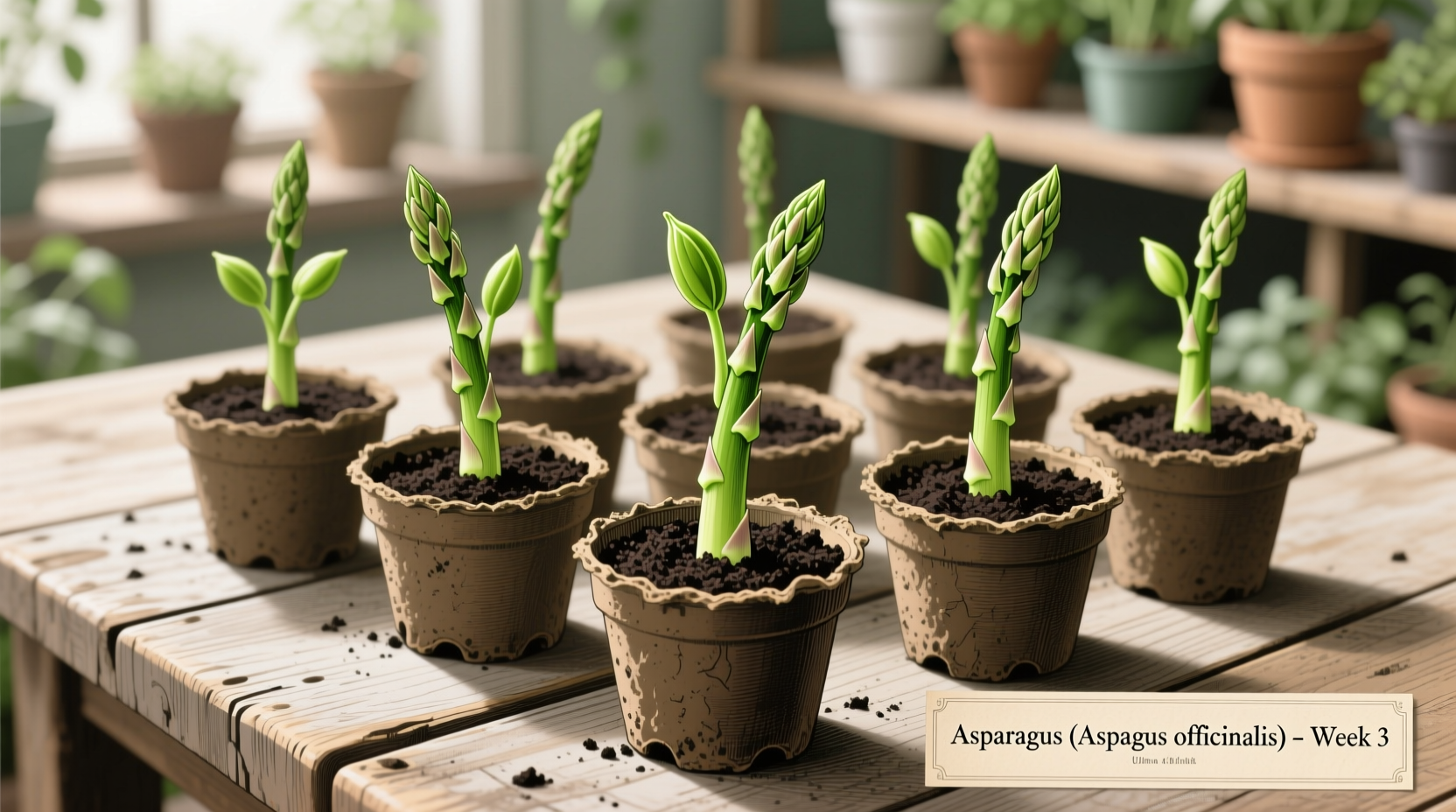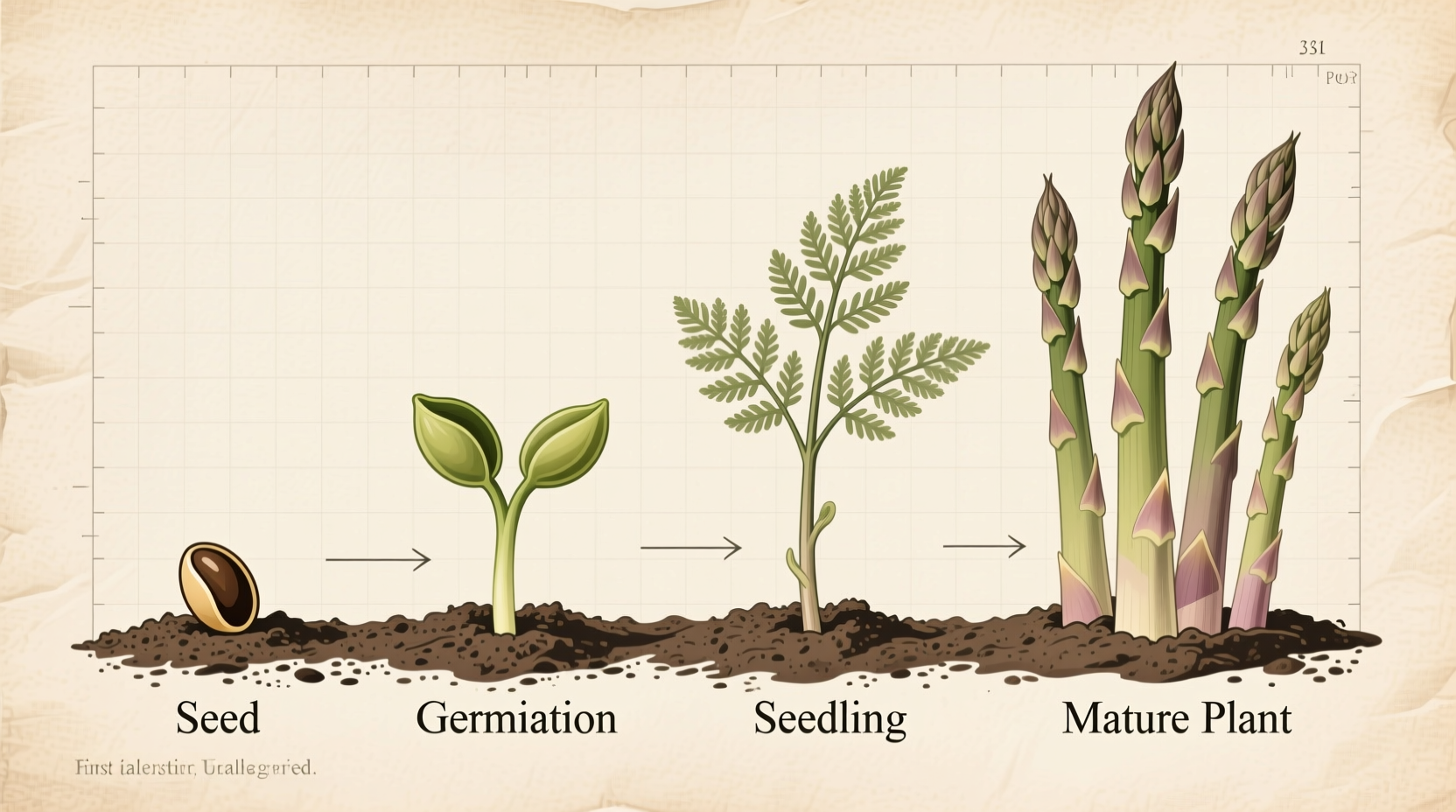Why Grow Asparagus from Seed Instead of Crowns?
While many gardeners opt for asparagus crowns for faster harvests, growing from seed offers distinct advantages. You'll access a wider variety selection, avoid potential disease transmission from nursery stock, and establish plants with stronger root systems. Though it requires patience—waiting 2-3 years for harvest—the payoff is a longer-lasting, more vigorous asparagus bed that can produce for decades.
Understanding Asparagus Growth Timeline
Asparagus is a perennial vegetable with a unique growth pattern. Unlike annual vegetables, it establishes a permanent root system that sends up edible spears each spring. The first year focuses entirely on root development with minimal visible growth. In year two, you'll see more substantial fern growth but still no harvesting. By year three, your patience pays off with a modest harvest that increases annually.
| Year | Root Development | Fern Growth | Harvest Potential |
|---|---|---|---|
| Year 1 | Establishing deep crown | Minimal, thin spears | No harvest |
| Year 2 | Expanding root system | Substantial fern growth | No harvest |
| Year 3 | Mature root network | Full fern canopy | 2-4 week harvest |
| Year 4+ | Maximum development | Dense, woody ferns | 6-8 week harvest |
Selecting the Best Asparagus Varieties for Seed Starting
When growing asparagus from seed, variety selection significantly impacts your success. Modern all-male hybrids outperform traditional varieties by eliminating energy-wasting female plants that produce seeds. According to the University of Minnesota Extension, male plants produce 20-30% more spears because they don't divert energy to seed production.
Top varieties for seed starting include:
- 'Jersey Knight' - Cold-hardy, high-yielding, rust-resistant
- 'Jersey Supreme' - Performs well in warmer climates
- 'UC 157' - Traditional variety still popular with home gardeners
Starting Asparagus Seeds Indoors
Asparagus seeds require a head start indoors due to their lengthy germination period and need for frost protection. Begin the process 14-16 weeks before your last expected frost date.
Seed Starting Process
- Soak seeds in lukewarm water for 24 hours to improve germination rates
- Plant in individual 3-4 inch pots filled with sterile seed starting mix
- Sow seeds 1/2 inch deep and maintain consistent moisture
- Keep at 70-85°F (21-29°C) for optimal germination
- Provide 12-14 hours of light daily once sprouts appear
Asparagus seeds germinate slowly—typically taking 2-8 weeks. The Iowa State University Extension confirms this extended germination period is normal and shouldn't cause concern if conditions remain consistent.

Transplanting Asparagus Seedlings
Transplanting requires careful timing and preparation for long-term success. Wait until seedlings reach 10-12 inches tall with established root systems, typically 12-14 weeks after sowing.
Site Preparation Checklist
- Choose a permanent location with full sun (minimum 8 hours daily)
- Test soil pH (ideal range: 6.5-7.5)
- Amend soil with 3-4 inches of compost and 2 inches of aged manure
- Create raised beds if drainage is questionable
- Remove all perennial weeds thoroughly
Asparagus needs excellent drainage to prevent root rot. The Oregon State University Extension emphasizes that poor drainage is the most common cause of asparagus bed failure in home gardens.
First-Year Care: Building Your Foundation
The first growing season focuses entirely on root development. Resist the temptation to harvest—this patience ensures decades of future production.
Critical First-Year Tasks
- Water deeply 1-2 times weekly (1-1.5 inches total)
- Mulch with 3-4 inches of straw or shredded leaves
- Fertilize with balanced organic fertilizer in midsummer
- Weed carefully to avoid root damage
- Allow all spears to develop into ferns
During dry periods, maintain consistent moisture without waterlogging. Asparagus roots can extend 6-10 feet deep over time, but young plants need more frequent watering until established.
Second-Year Development and Care
In the second year, your plants will develop more substantial fern growth but still require patience—no harvesting yet. This continued growth builds the energy reserves needed for future harvests.
Continue the same care routine as year one, but increase fertilizer application slightly. Watch for signs of nutrient deficiency:
- Yellowing ferns may indicate nitrogen deficiency
- Purple-tinged foliage suggests phosphorus shortage
- Brown leaf margins could mean potassium deficiency
Harvesting Timeline: When and How to Cut Spears
Year three marks your first harvest opportunity, but restraint remains crucial. Follow this harvesting schedule for optimal long-term production:
- Year 3: Harvest for 2-4 weeks when spears reach 6-8 inches tall
- Year 4: Extend harvest to 4-6 weeks
- Year 5+: Full 6-8 week harvest season
To harvest properly, cut spears at soil level with a sharp knife when they're 6-8 inches tall and before tips begin to fern out. Never remove more than 1/3 of the emerging spears during harvest season to maintain plant health.
Climate Considerations for Asparagus Success
Asparagus grows best in temperate climates with distinct seasons, but can adapt to various conditions with proper variety selection. Understanding your climate limitations is essential when growing asparagus from seed:
- Cold climates (Zones 3-5): Choose cold-hardy varieties like 'Jersey Knight' and apply winter mulch after ferns die back
- Moderate climates (Zones 6-7): Most varieties perform well with standard care
- Warm climates (Zones 8-10): Select heat-tolerant varieties like 'Jersey Supreme' and provide afternoon shade
The North Carolina State University Extension notes that asparagus requires a winter dormancy period with temperatures below 50°F (10°C) for at least 8 weeks to reset for spring growth—making it challenging in tropical climates.
Troubleshooting Common Asparagus Growing Problems
Even with careful planning, challenges may arise. Address these common issues promptly:
Slow or Uneven Germination
If your asparagus seeds aren't sprouting uniformly, check these factors:
- Soil temperature below 70°F (21°C)
- Inconsistent moisture levels
- Old or poor-quality seeds
- Planting too deep
Poor First-Year Growth
When seedlings struggle after transplanting:
- Verify soil drainage—standing water causes root rot
- Check for nutrient deficiencies through soil testing
- Ensure adequate sunlight (minimum 8 hours daily)
- Monitor for pests like asparagus beetles
Long-Term Asparagus Bed Maintenance
Well-maintained asparagus beds can produce for 25 years or more. Implement these practices for sustained productivity:
- Apply 2-3 inches of compost annually in early spring
- Cut back dead ferns in late winter before new growth appears
- Divide overcrowded plants every 10-15 years
- Rotate nitrogen-fixing cover crops in pathways
- Monitor for emerging pests and diseases
As your bed matures, you'll notice increased spear production and thickness. The patience invested in growing from seed pays dividends through stronger, longer-lived plants compared to those started from crowns.
Final Thoughts on Growing Asparagus from Seed
While growing asparagus from seed demands patience and careful planning, the rewards of establishing your own long-term asparagus bed make the effort worthwhile. By following these detailed steps for seed selection, planting, and care, you'll create a productive asparagus patch that becomes a permanent, productive feature of your garden for decades to come. Remember that each year of waiting builds toward greater future harvests—truly a case where slow and steady wins the race.











 浙公网安备
33010002000092号
浙公网安备
33010002000092号 浙B2-20120091-4
浙B2-20120091-4